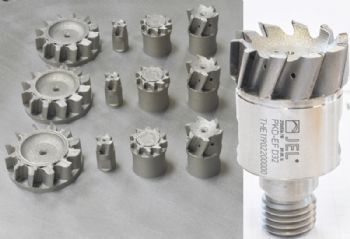
Komet Group is using Renishaw metal additive manufacturing (AM) technology to produce new ranges of cutting tools. As well as allowing special cutters to be produced more quickly, the use of AM allows more-complex shapes to be generated, both for the external shape of the tooling and for the internal cooling channels.
Komet, which has been supplying precision cutting tools for almost 100 years, has its headquarters in Besigheim and currently employs more than 1,500 people.
It is represented in some 50 countries and is best known for its drilling, reaming, milling and threading tools — plus its process monitoring solutions.
The company has also established a reputation for developing tailored products designed to help customers achieve greater efficiency at all stages of their machining processes.
With such a strong focus on innovation and continuous development, it was perhaps inevitable that Komet engineers would come up with tooling designs that were too costly — or even impossible — to make with conventional manufacturing methods.
As a result, Reinhard Durst (R&D manager for hard metal tools) has been investigating the potential of AM for tooling production and looking at the equipment available.
For the last year, he has been working with Renishaw (
www.renishaw.com), “because its offer convinced us from a technical as well as an application point of view.
“Moreover, Renishaw’s growing network of Additive Manufacturing Solutions Centres means that customers can lease the latest Renishaw equipment and work independently on their projects. That said, Renishaw staff are always available to provide advice on the use of the machines.
“In this way, potential customers can familiarise themselves with additive manufacturing technology with expert help on hand, and discover how it might meet their specific requirements — without the need for a large up-front investment.”
Win-win situation
Ralph Mayer, the manager responsible for additive manufacturing services at Renishaw GmbH, said: “We are aiming for a win-win situation. With our support, the customer shortens their learning curve and keeps the number of potential mistakes to a minimum.
“We only raise the question of purchasing a system when the customer is clear that it will provide added value for them. At the same time, we gather valuable information about the needs of the industry, which we can use to develop our machines and technology further.
“The structure of parts produced with additive manufacturing can reach a consistency of up to 99.9% — just like rolled or cast metal components — but the correct strategy must be applied for every component. Our strength lies in our skill relating to analysing the technical challenges of our customers’ components and working with our customers to find the most effective solution.”
Renishaw’s metal AM system uses laser powder bed fusion technology in an inert argon atmosphere. An extremely thin bed of metal powder is laid down, and areas that will form the component are melted using a high-performance ytterbium fibre laser and then solidified on cooling.
This process is repeated with layers of metal powder, typically between 20 and 60μm thick, until the part is finished. The thinner the layers, the better the accuracy and surface quality of the finished part.
The first project handled jointly by Komet and Renishaw was the development of a new range of poly-crystalline diamond (PCD) screw-in milling cutters.
The main bodies of the cutters, which are manufactured on a Renishaw metal AM system (a number of bodies are produced during each cycle of the machine), are subsequently fitted with PCD blades and screwed onto their tool-holders.
Machining performance
Dr Durst says the use of the Renishaw technology to manufacture the tools allows Komet to produce geometries that would be almost impossible to achieve by conventional means.
“Thanks to the additive process, we have been able to place many more PCD blades on each tool; and by changing the arrangement of the blades, we have also been able to achieve a substantially greater axis angle.
“Compared to conventional milled tools, our AM versions are significantly more productive. For example, for a 32mm-diameter screw-in head, the number of blades has been increased from six to 10, allowing the use of feed rates up to 50% greater.

“Furthermore, the ability to optimise the paths of the coolant channels ensures that each cutting edge is supplied precisely with coolant through a separate channel, while the external design of the bodies helps to ensure that chips are removed reliably from the face of the tool.
“AM also offers the potential to reduce tool weight, since material can be used only where it is needed for optimum functionality.
“It also out-performs conventional production methods in terms of delivery time for any special or experimental tools needed by Komet’s customers.
“The ability to freely design the internal and external tool geometry alone means that excluding this additive process from our future plans would be inconceivable.
“It gives us the ability to significantly increase tool performance and productivity, thereby creating considerable added value for our customers.”
Dr Durst says the decision to work in partnership with Renishaw has been fully justified. “It is not easy for a company that is new to metal AM technology to work out the best laser parameters on its own. Renishaw has contributed a wealth of knowledge to help us find the parameters that are needed to produce a good tool.
“The new design freedom offered by AM technology and the co-operation with Renishaw are helping us to develop even more innovative tool solutions.”